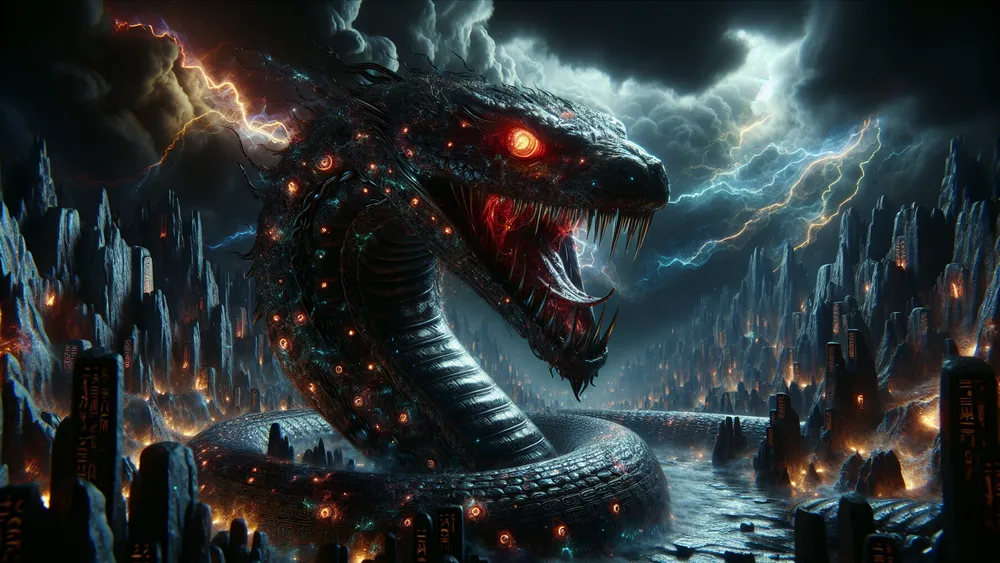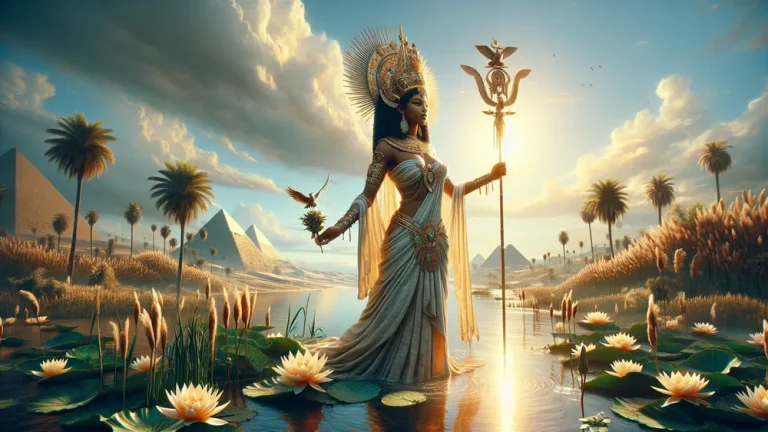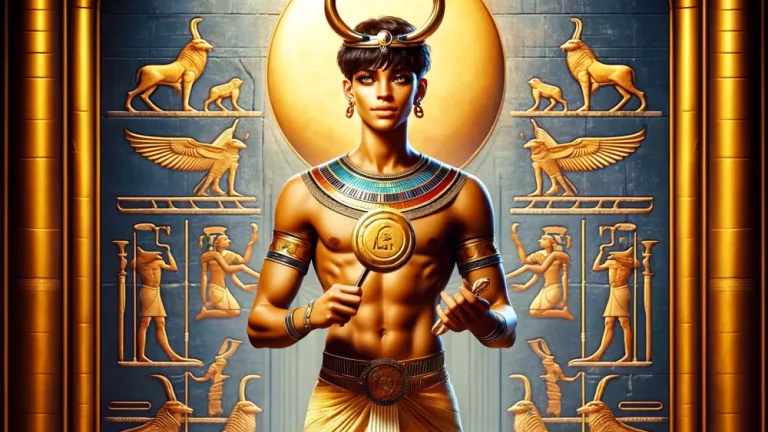Apophis: Egyptian Deity Of Darkness And Chaos
Welcome to this thing about Apophis, also called Apep, the Egyptian god of darkness and chaos. Think about a place where, every night, a big snake tries to swallow the sun, making everything dark forever. Apophis’s job in Egyptian myths is this. He is the enemy of the sun god Ra.
Key Points:
- Apophis is the Egyptian god of darkness and chaos, known for trying to swallow the sun every night.
- He represents confusion, darkness, and disruption in Egyptian mythology.
- Apophis is often shown as a giant snake or dragon in ancient Egyptian art.
- He symbolizes the ongoing battle between order (Ma’at) and chaos (Isfet) in Egyptian stories.
- Egyptians performed rituals and acts to protect against Apophis and maintain cosmic order.
- Apophis’s significance in ancient Egyptian mythology lies in his role as a constant threat to cosmic balance.
- Today, Apophis’s character is still influential in modern books, movies, and TV, reflecting chaos and destruction.
In this blog, you will learn about where he came from, why he matters, the fights in the stories involving him, how he was shown in old art, and how he affects stuff today, modern things.
If you don’t know much about myths or you know a lot, this will help you understand a very interesting and fierce part of Egypt’s old gods.
Apophis: Overview and Key Facts
| Main Point | Details |
|---|---|
| Title | Apophis (also called Apep) |
| Myth Role | God of darkness and confusion, Ra’s enemy |
| Showing | Seen as a huge snake or dragon |
| Importance | Means confusion, darkness, breaking things; tries to mess up the universe |
| Where He Comes From | Came from endless disorder; linked with Isfet (disorder) |
| Sky Fight | Has nightly fights with Ra in the underworld, showing the battle between order (Ma’at) and disorder (Isfet) |
| Effect on Culture | Key in rituals against disorder; important for keeping the world balanced |
| Art Showing | Usually displayed as a big snake or dragon in old Egyptian drawings and writings, showing his messy nature |
| Today’s Views | Appears in many books, movies, TV; still affects modern stories and popular things |
| Rituals and Acts | Old Egyptians used spells, prayers, rituals to fight Apophis; priests did these acts |
| Symbols | Snake shape shows confusion and wrecking; stands for Isfet forces |
| Linked Beings | Linked with other gods and beings in Egyptian stories; mainly known for fighting Ra |
| Events and Acts | Festivals focused on Ra beating Apophis, making sure the sun rises daily and keeping the world in order |
| Role in Stories | Shows the constant danger of disorder and the need to keep order; fights with Ra are vital for life and the world’s continuation according to old Egyptians |
Getting to Know Apophis
To really grasp the importance of Apophis in the stories of ancient Egypt, it is necessary, we need to look more into his identity, where he came from. Also, the part he plays in the big fight between order and chaos.
Who is Apophis?
Apophis, called Apep, is an important person in ancient Egyptian stories, showing dark and chaotic forces. Think of a huge snake or dragon hiding in the dark, waiting to hit the heart of everything. This is how Apophis is often shown in old writings and pictures.
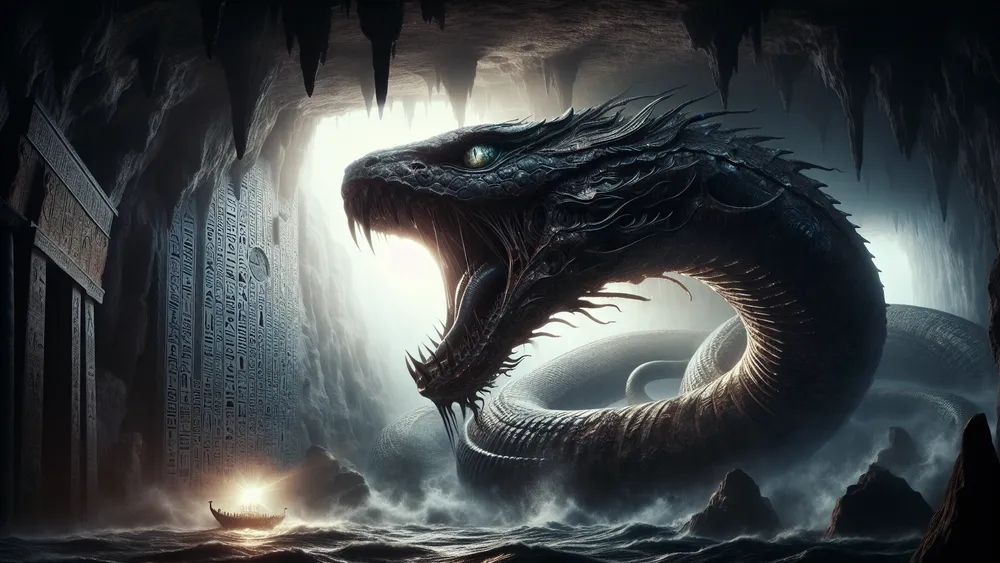
As the never-ending enemy of the sun god Ra, Apophis’s main job is to mess with the universe’s order. Every night, as Ra moves through the underworld on his sun boat, Apophis tries to eat the sun, showing the ongoing danger of chaos taking over light and order that Ra stands for.
In old Egyptian life, Apophis’s importance cannot be missed. He is closely tied to chaos, darkness, and breaking things, showing the idea of Isfet, which is the opposite of Ma’at, the idea of order and peace. They thought Apophis’s tries to eat the sun put the whole universe in danger. To see how he mattered, think of how ancient Egyptians saw balance in the world: anything that messed up this balance could lead to huge troubles. Main points about Apophis’s importance include:
- Chaos and Darkness: Apophis means the constant danger of chaos and darkness.
- Cosmic Threat: What he did was thought to endanger the universe’s order kept by Ra.
- Cultural Practices: The Egyptians made many rituals and actions to fight his power and make sure the sun rose each day.
By knowing Apophis’s role and importance, we learn more about how the old Egyptians saw the world and how they worked to keep everything in balance.
Mythological Origins and Role
Where Apophis comes from in Egyptian stories is deep in the idea of really old chaos. It’s said that Apophis came out from the messy waters of Nun, the ancient ocean that was there before anything else. This link, the chaos one, it’s at the heart of who he is.
Old stories say Apophis is a force older than the ordered world, standing for dark and messy things. Ra, the sun god, always fights against. One story, it tells of Apophis waiting every night to hit Ra’s sun boat as it goes through the underworld, showing the never-ending fight between chaos and order.
If you look at other old stories, Apophis is like Tiamat in stories from Mesopotamia. Tiamat, like Apophis, is an ancient chaos god, and she is often shown as a big snake or dragon. Both mean the messy forces that could mess up the world’s order.
These likenesses, they show a common theme in old stories: chaos shown as a big snake enemy that must be beaten to keep balance and peace in the world.
In Egyptian tales, understanding Apophis needs knowing Ma’at and Isfet. Ma’at means order, truth, and fairness. It’s very important for keeping everything in balance. Isfet is the opposite. It means chaos, lies, and mess. Apophis, he stands for Isfet, always fighting the forces of Ma’at. His nightly fights with Ra, they aren’t just physical fights but also symbols of the ongoing battle between order and chaos. Key points about this world fight:
- Ma’at: The idea of order, truth, and fairness, needed for world balance.
- Isfet: The idea of chaos, lies, and mess, shown by Apophis.
- Apophis’s Job: Standing for Isfet, showing chaos and dark.
- World Fight: Apophis’s constant fight with Ra and the forces of Ma’at, important for the world’s continuation.
By knowing these ideas, we get a better view of the old Egyptians’ world view and how much Apophis mattered in their stories.
The Fight Against Apophis
To fully see the importance of Apophis in Egyptian stories, we must, it is necessary to look at the different myths and rituals that show the ongoing fight between order and chaos.
Order vs. Chaos
One interesting part of Egyptian stories is Ra’s night trip through, called the Duat. His night trip on his sun boat, Ra faces many challenges, the biggest one is meeting Apophis. Apophis, huge snake, waits to eat Ra and bring endless dark.
These fights each night, not only real fights but show how order and chaos fight. Egyptians thought Ra winning over Apophis was needed for the morning sun, keeping life going and order in the world.
To stop Apophis, Egyptians had many rituals and acts. They used spells, prayers, and acts to stop Apophis’s bad power. Priests and magic workers were important in these acts; they spoke certain words to stop Apophis. The acts showing Apophis losing were important, showing order winning over chaos. Ra winning was seen as key, making sure the sun came up daily and keeping Ma’at going. They had events and rituals to remember this win, showing how important it was to keep the world’s balance. Main points about these acts include:
- Spells and Prayers: Used to stop Apophis.
- Role of Priests and Magicians: Important in doing acts to stop Apophis.
- Symbolism: Apophis losing showed order beating chaos.
- Ra’s Victory: Made sure the sun came up each day, life went on.
- Events and Rituals: Remembered Ra’s win and showed the need to keep balance.
By knowing these stories and acts, we understand more about how Egyptians tried to keep balance between order and chaos and what they did to keep it.
Depictions and Symbolism of Apophis
If you want to understand Apophis in Egyptian mythology better, you must look at how he was shown in old art and writings. It is important to know the meanings linked to how scary he looked.
Appearance and Symbolism
In old Egyptian pictures and writings, Apophis is mostly shown as a giant snake or dragon, being the essence of chaos and badness. Often, his snake shape has big parts, like a huge, wide mouth and sharp, scary teeth, showing he is a threat. They also made him with many scales and long, never-ending coils, meaning he is always there.
They made these scary pictures to make people afraid and to show how hard it is to beat him, especially for Ra.
The meanings of how Apophis looks are tied to him being chaos and breaking things. The snake shape alone is a strong sign in many cultures, often tied to danger and wild forces of nature. For old Egyptians, Apophis being a snake means he shows the always-there threat of disorder and big changes in the world. Other signs and things about Apophis might be:
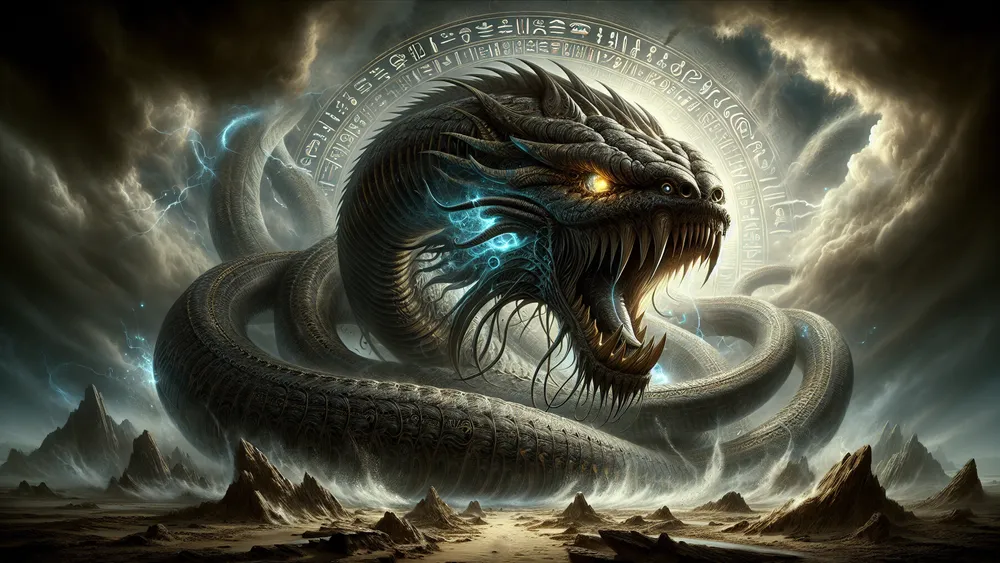
- Darkness: Meaning no light and no order.
- Endlessness: His long coils mean chaos never ends.
- Destruction: His teeth and wide mouth mean he can eat and destroy everything.
By knowing these signs, we see how old Egyptians used pictures and signs to show the big threat Apophis was to how they thought about the world.
Family and Relationships
In Egyptian stories, Apophis is often shown alone. He is chaos and destruction without a family tree. He has main links to disorder and darkness; he is chaos alone. However, he sometimes connects to other bad beings. His most important link is with Ra, the sun god.
He is always fighting Ra in the underworld. This opposing link with Ra is crucial because Apophis trying to eat Ra shows chaos threatening order. To know Apophis better, look at the gods and creatures linked to him. Below is a table showing these links, the roles, and their importance:
| Name | Role | Importance |
|---|---|---|
| Ra | Sun God | Apophis’s main enemy, order and light. |
| Set | Chaos and Storms God | Sometimes helps fight Apophis. |
| Snakes | Mean Creatures | Show Apophis’s bad and chaotic nature. |
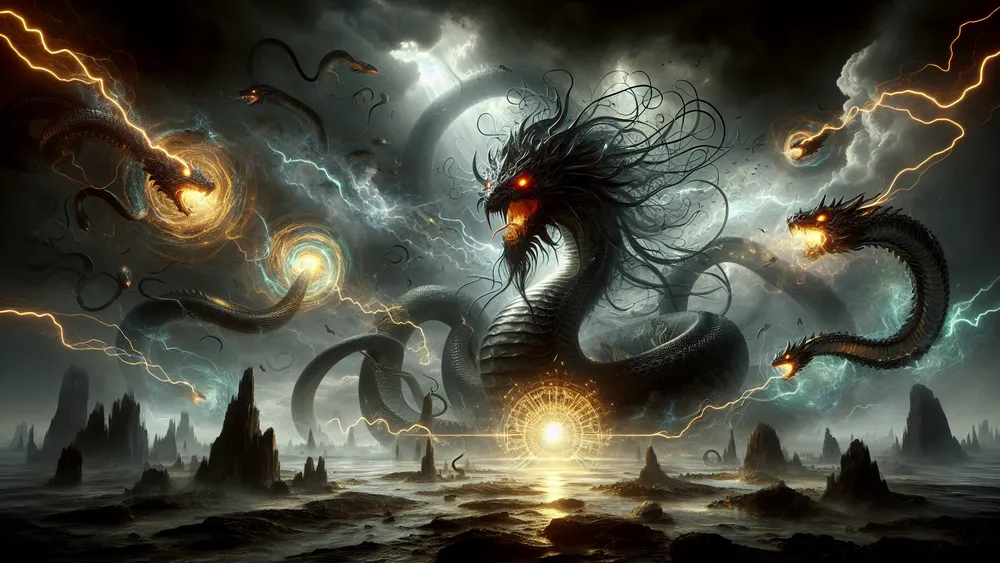
By looking at these links, we see how Apophis fits into Egyptian stories. He is the always enemy of order and light.
Apophis in Today’s Culture
To know about Apophis’s old beginnings and what he meant helps us see how this scary god is seen and shown in modern times. He is important then and now. Understanding his role lets us see new ways he is shown today.
Modern Interpretations
In today’s books and shows, Apophis is often shown in many ways, focusing on him as chaos and destruction. For example, in Rick Riordan’s “The Kane Chronicles” books, Apophis is a strong enemy wanting to bring darkness.

Also, in the TV show “Stargate SG-1,” Apophis is thought of again as a strong alien enemy, taking his old story to make him full of badness and strength. These new ways of showing him often focus on his scary side while changing his story to fit now’s stories and types.
The effect of Apophis in today’s popular culture is big, and it changes modern stories and popular stuff in many ways. His old story is used in many made-up stories, where fights between chaos and order happen a lot. Here are some ways we see this:
- Books: Stories that use old myths and think about what they mean now.
- Movies and TV: Films and shows that take old stories to share with new people.
- Studies and Learning: People still want to know more about what Apophis meant and why he was important.
By looking at these new ways of showing and their effects, we can understand that Apophis’s old story still matters, giving lots of things to talk and think about even now.
Pantheon of Egyptian Mythology Creatures
Egyptian myths have many gods, goddesses, and creatures. Each one has a different job in what they believed. From good gods who kept order to bad ones like Apophis who were chaos, these figures all shaped old Egypt’s spiritual and cultural world.
For a big picture of these interesting beings, you can check out this list of all the Egyptian creatures. This page has details on the various gods, goddesses, and beings in Egyptian myths. It gives facts about their stories, what they did, and why they were important.
FAQs
1. What is the significance of Apophis in Egyptian mythology?
The significance of Apophis in Egyptian mythology lies in his role as the embodiment of chaos and his constant battle against the sun god Ra to disrupt cosmic order.
2. How did ancient Egyptians protect themselves from Apophis?
To protect themselves from Apophis, ancient Egyptians used rituals, spells, and prayers performed by priests and magicians.
3. What are some myths involving Apophis?
Some myths involving Apophis include his nightly battles with the sun god Ra during Ra’s journey through the underworld.
4. How is Apophis depicted in ancient Egyptian art?
In ancient Egyptian art, Apophis is typically depicted as a giant serpent or dragon, symbolizing chaos and destruction.

